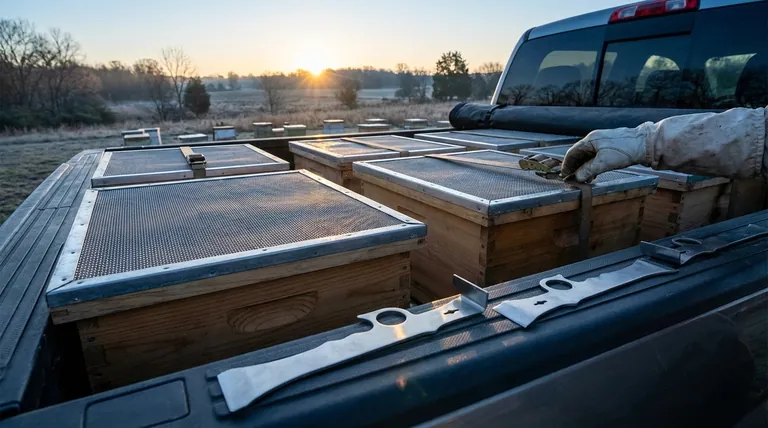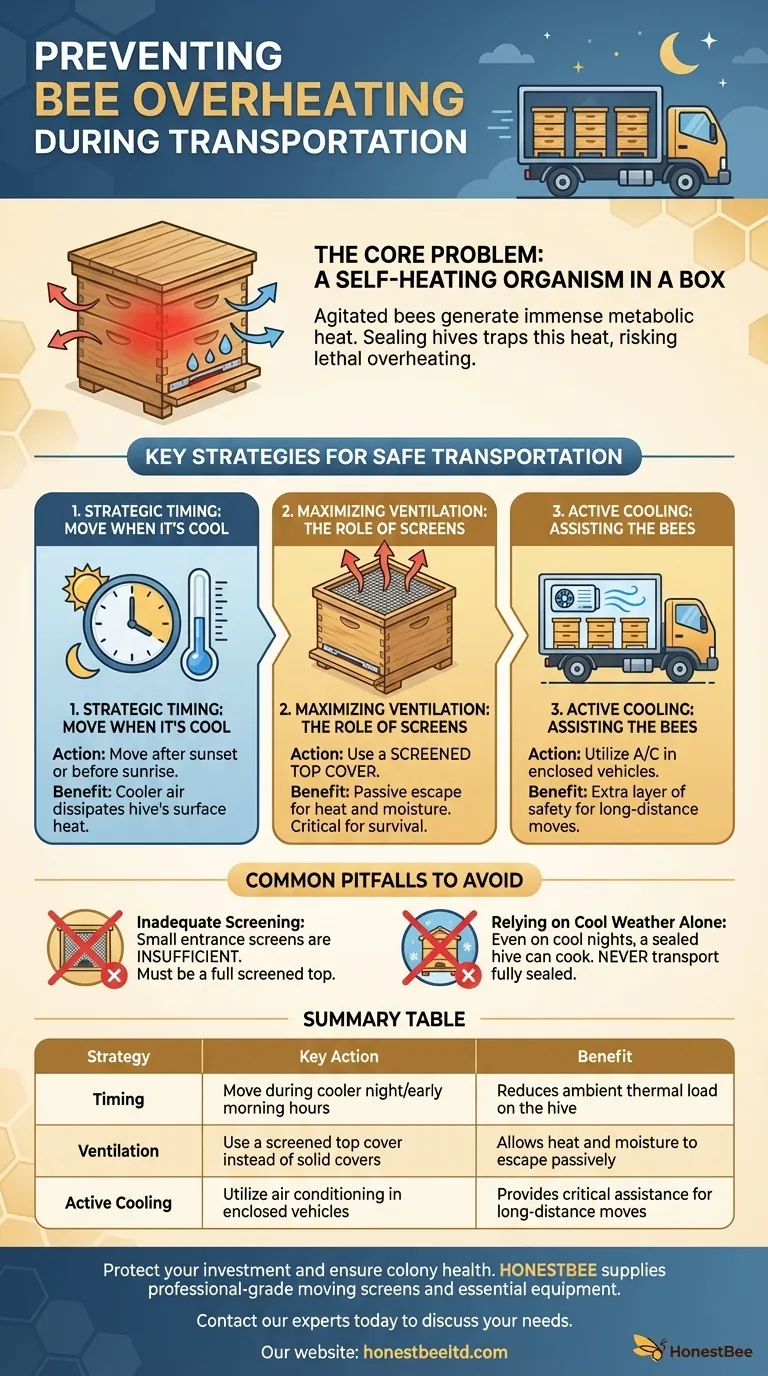To prevent bees from overheating during transportation, you must focus on three critical factors: timing the move for cooler temperatures, ensuring maximum ventilation with screened covers, and providing active cooling when necessary. The primary goal is to manage the immense heat a stressed and confined colony generates, as their natural cooling mechanisms are severely restricted.
The core challenge of moving bees is not the movement itself, but managing the heat generated by thousands of agitated insects in a confined space. Success depends entirely on providing a way for that heat to escape.

The Core Problem: A Self-Heating Organism in a Box
A honeybee colony is a superorganism that actively regulates its own temperature. When you seal and transport a hive, you disrupt this delicate balance, creating a dangerous feedback loop.
Why Agitation Creates a Heat Crisis
When a hive is moved, the vibration and jostling cause widespread agitation. Stressed bees increase their metabolic rate, consuming honey and generating a tremendous amount of heat as a byproduct.
The Danger of a Sealed Hive
A standard hive is designed for insulation and defense, with a small entrance for ventilation. Sealing this entrance for transport traps all the metabolic heat and moisture inside. Without a way to vent this build-up, the internal temperature can rise to lethal levels in a very short time.
Key Strategies for Safe Transportation
Your strategy must directly counteract the heat generated by the agitated colony. Passive and active cooling methods are not optional—they are essential for survival.
Strategic Timing: Move When It's Cool
The single easiest variable to control is the ambient temperature. Always plan your move for the coolest part of the day.
Moving after sunset or before sunrise gives you the greatest advantage. The cooler air helps dissipate heat from the hive's surface, reducing the overall thermal load on the colony.
Maximizing Ventilation: The Role of Screens
Passive ventilation is the most critical component of a safe move. This is achieved by replacing solid hive covers with a screened alternative.
A moving screen or screened inner cover replaces the standard inner and outer covers. This large surface area allows heat and moisture to escape while keeping the bees securely contained. It lets the bees' own fanning behavior work to push hot air out of the hive.
Active Cooling: Assisting the Bees
For long-distance moves or transport in enclosed vehicles, passive ventilation may not be enough. Active cooling provides an extra layer of safety.
If moving hives in an enclosed truck or van, use air conditioning to keep the cargo area cool. In an open-bed truck, the airflow from driving helps, but ensure the hives are not in direct sunlight. Even opening the windows of a car can make a significant difference.
Common Pitfalls to Avoid
Simple mistakes during preparation can have catastrophic consequences. Understanding these risks is as important as knowing the correct procedures.
The Risk of Inadequate Screening
Do not assume a small screened entrance is sufficient. This is a common and fatal mistake. The ventilation area must be large enough to handle the heat output of the entire colony; a full screened top is the professional standard.
Believing Cool Weather Is a Guarantee
Even on a cool night, a large, populous colony can generate enough internal heat to cook itself if ventilation is poor. Never transport a fully sealed hive, regardless of the outside temperature.
Forgetting About Water
Bees also use evaporative cooling (placing water droplets and fanning them) to manage heat. While you can't provide an open water source during a move, ensuring the colony is well-hydrated and not stressed beforehand can improve their resilience.
Making the Right Choice for Your Move
Your specific transport plan will depend on the distance, weather, and colony size.
- If your primary focus is a short, local move: Prioritize moving at night and using a proper top moving screen for ventilation.
- If your primary focus is a long-distance move: Combine night moving and top screens with active cooling, such as an air-conditioned vehicle.
- If your primary focus is moving a small nucleus colony: The risk is lower, but the principles are the same; always provide adequate top ventilation.
Ultimately, your responsibility is to provide the external ventilation the bees cannot create for themselves while confined.
Summary Table:
| Strategy | Key Action | Benefit |
|---|---|---|
| Timing | Move during cooler night/early morning hours | Reduces ambient thermal load on the hive |
| Ventilation | Use a screened top cover instead of solid covers | Allows heat and moisture to escape passively |
| Active Cooling | Utilize air conditioning in enclosed vehicles | Provides critical assistance for long-distance moves |
Protect your investment and ensure the health of your colonies during transport. HONESTBEE supplies commercial apiaries and beekeeping equipment distributors with wholesale-focused, professional-grade supplies, including durable moving screens and essential equipment designed for safe hive transportation. Contact our experts today to discuss your specific needs and secure the right equipment for your operation.
Visual Guide

Related Products
- HONESTBEE Advanced Ergonomic Stainless Steel Hive Tool for Beekeeping
- Versatile Ratchet Hive Strap with S-Hooks for Secure Fastening
- HONESTBEE Classic Pry Bar Hive Tool with High Visibility Finish for Beekeeping
- Professional Galvanized Hive Strap with Secure Locking Buckle for Beekeeping
- Professional Drop-Style Hive Handles for Beekeeping
People Also Ask
- What are some common uses of a hive tool? Essential Multi-Purpose Tool for Every Beekeeper
- What are the features of a regular hive tool? The Essential Multi-Tool for Every Beekeeper
- What are the basic tools for beekeeping? Essential Starter Kit for Safe & Successful Hive Management
- What is the hole in a hive tool for? A Multi-Tool for Apiary Repairs and Maintenance
- How is a hive tool used for scraping and cleaning? Master Hive Maintenance for a Healthy Colony



















